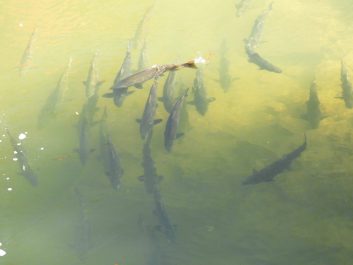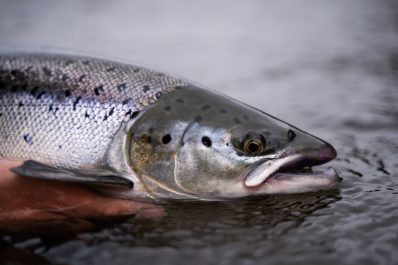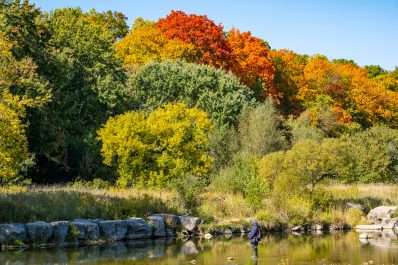September 19, 2025
As water temperatures start to cool and fall rains cause water levels to deepen, salmon begin their yearly trek from Lake Ontario up along the Credit River to spawn and complete their life journey.
The salmon run starts in mid September and peaks in early October, with most fish completing their journey by late October.
Types of salmon
There are three types of salmon that call the Credit River home:
- Chinook salmon: This species migrates once they reach maturity (between three and seven years) and typically dies after spawning is complete. Chinook are the largest of the salmon species as they can grow up to approximately 100 centimetres in length. Chinook salmon have a dark mouth and black gums at the base of their teeth.
- Atlantic salmon: Atlantic salmon were once abundant in the Great Lakes until the late 1800s. Extensive efforts to restore populations have resulted in small populations in Lake Ontario and its tributaries including the Credit River. Unlike Chinook salmon, this smaller salmon species makes its way back to Lake Ontario after its migration upstream. Atlantic salmon are the only salmon species native to Lake Ontario. Atlantic salmon have large black spots on their gill covers and back, and no spots on their tail fin.
- Coho salmon: While smaller than the Chinook, both species are native to the north Pacific Ocean and were introduced to the Great Lakes in the 1960s. Coho can grow to approximately 75 centimetres in length. Coho salmon have a white mouth line, a black tongue and sharp teeth.

See the salmon run
Across Mississauga, there are several great locations along the Credit River where you can easily view the salmon as they make their journey.
- Erindale Park: The City’s largest park offers extensive trails through ravines and open spaces giving you lots of chances to get up close to the Credit River.
- Riverwood: This 150-acre park and urban oasis includes accessible trails and great views. The Credit River flows through the park’s western border, offering excellent spots to watch the salmon run.
- Meadowvale Conservation Area: Located in the north part of the City, this natural oasis gives you a good opportunity to watch the migration from a pedestrian bridge overlooking the Credit River.
Witnessing the journey of these fish is truly incredible when the odds of making it to their destination are heavily against them. So, as we watch these fish swim, it’s important to do so in a way that won’t impede their journey.
Respect the run
While the salmon run can be incredible to watch, please be mindful that nature is at work! Many salmon won’t survive the swim upstream, and the ones that do still have to lay their eggs. Their journey can also be made more difficult by spectators trying to get a closer look. Here’s how you can watch the salmon run while respecting the salmon:
- Watch from a safe distance: When you’re out and about, give salmon the best chance of survival by respecting their space. That includes steering clear of areas where salmon are swimming and along the riverbed where they lay and fertilize their eggs. Avoid standing directly in the river or throwing rocks or branches to disrupt the water as it can stress the fish out on their journey. Remember not to chase, touch or abuse the salmon.
- Keep the river clean: if you see litter around the river, please dispose of it properly. Fishing lines and lures can end up injuring fish, as well as local wildlife like swans, ducks, geese and turtles. Remember to take all hooks, fishing lines, garbage and other items with you when you are done fishing. Please don’t leave them behind. Some fishing locations across Mississauga (mostly along Lake Ontario and at Lake Aquitaine) have fishing line collection tubes for anglers to dispose of old fishing lines.
- Enjoy the silence: Avoid being disruptive and lower your voice when watching the salmon. Try watching quietly and respectfully.

Fishing during the salmon fall migration
Fishing is always a fun time, but during the salmon run, it’s important that they are released so they can continue on their way. As salmon swim upstream, they are vulnerable to illegal fishing practices such as netting and snagging. In order to ensure a sustainable fishery, those fishing in Mississauga waters must abide by and follow Provincial rules and regulations (for Zone 16) when it comes to fishing. These rules and regulations include species-specific angling timelines, approved angling gear types and methods, along with locations where fishing is permitted. If you see someone abusing the rules, please report it by calling 1-877-847-7667 (1-877-TIPS-MNR).
Fishing is, however, still open in the following areas:
- Year-round open season in the Credit River and tributaries from the south side of the Highway 403 bridge downstream to Lake Ontario.
- Extended fall season from the fourth Saturday in April until December 31 in the Credit River and tributaries from the south side of Britannia Road upstream to the south side of the Highway 407 bridge.
- Fish sanctuary (no fishing) in the Credit River and tributaries from the south side of the Highway 403 bridge upstream to the south side of the Britannia Road bridge from January 1 to the Friday before the fourth Saturday in April, and August 15 to December 31.
- Fish sanctuary (no fishing) in the Credit River and tributaries (excluding Fletchers Creek and Levi Creek) from the south side of the Britannia Road bridge upstream to Old Baseline Road bridge in the Town of Caledon between January 1 and the Friday before the fourth Saturday in April.
After the run, what happens next?
Towards the end of their life cycle, many salmon species, like the Coho and Chinook, will die soon after they lay eggs. Atlantic salmon are different from Coho and Chinook salmon, as they live past the spawning point, and may lay eggs multiple times throughout their lives. In the spring, offspring from all three species hatch and will make their way downstream. Chinook salmon will often leave right in the spring when water levels rise, while Coho and Atlantic Salmon may spend more time in their nursery river before moving downstream. They make their home in Lake Ontario until maturity when it’s time to migrate back upstream to their home rivers to reproduce.
Dead salmon are an important food source for the Credit River’s ecosystem. As they decompose, they add important nutrients back into the water. It is recommended that people avoid touching or eating rotting fish.
Watch videos of salmon in the Credit River or learn more about the Credit River Watershed by visiting the Credit Valley Conservation website at cvc.ca.


